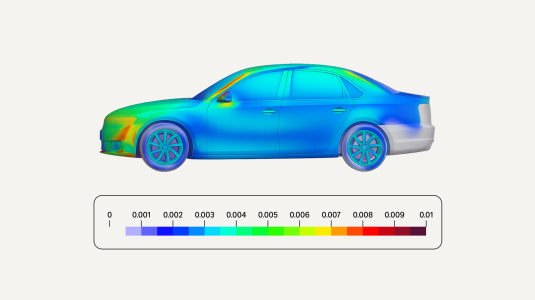From airplane wings to integrated circuits, the physical world is being shaped by digital innovation, and vice versa. At the Massachusetts Institute of Technology, scientists at the Center for Bits and Atoms (CBA) study "how to turn data into things, and things into data," as the center's website puts it.
Neil Gershenfeld, the CBA's director and recipient of a 2019 Amazon Machine Learning Research Award (MLRA) for his work on design morphogenesis — he calls it "the design of design" — talks about his work and the future of computing.
Conversation has been edited for length and clarity.
Q. In your book Designing Reality, you refer to three digital revolutions. The first was in communication, going from phones to the Internet, and the second was in computation, with personal computers and smartphones. The third, you predict, will be in fabrication. How does that connect to your work at the Center for Bits and Atoms?
I never understood the boundary between physical science and computer science. I take credit for the observation that computer science is one of the worst things to happen to computers or to science. What I mean by that is, the canon of computer science is fundamentally unphysical.
Computer science, as it's taught in practice today, happens in abstract digital worlds. It's a bit like the movie Metropolis, where people frolic in the garden and somebody moves the levers in the basement — the basement here is things like data centers, where you actually figure out how to do the computing. Tremendous amounts of power, communication, bandwidth, and inefficiency go into making physical computers act like virtual spaces.
There's a completely different lineage. The founders of modern computing architecture, John von Neumann and Alan Turing, both investigated the physical form of computing. Von Neumann studied self-reproducing automata: how a computer can communicate its own construction. Turing studied morphogenesis: how genes give rise to form. Neither of them was studying computing in a cloud, but rather computing as a physical resource.
That's at the heart of the work of CBA — of embodying computing, not abstracting computing. Fundamentally aligning the representations of hardware and software for scalability, for efficiency, for productivity. To move bits into atoms, and atoms into bits.
Q. Can you talk more about the concept of design morphogenesis and what that entails?
So this was one of the last things that Turing studied: how genes give rise to form. It's really at the heart of life.
Your genome doesn't anywhere store that you have five fingers. It stores the developmental program, and the developmental program resides in one of the oldest parts of the genome, called Hox genes. It encodes steps like, "grow up a gradient" or "break symmetry." When you follow those steps, at the end, you have five fingers.
Morphogensis: an explainer
Science Direct defines morphogenesis as "a biological process that causes a tissue or organ to develop its shape by controlling the spatial distribution of cells during embryonic development."
There's a very deep parallel with machine learning. Modern machine learning hasn't found better ways to search. It's found better representations of search — where to search in ways that are interesting. Today in engineering design, it's almost tautological that the design represents the thing you're designing. If you're designing an airplane or a chip, you represent the airplane or the chip.
But again, that's not what biology does. So in the morphogenesis project, we've been looking at how to design by searching over developmental programs. One of the warm-up problems we did — one that was much harder than I originally thought — was gear design. Gear design is surprisingly subtle and represents centuries of experience. We showed we could rediscover centuries of experience in gear design by searching over algorithmic representations of gears rather than explicit designs of gears.
Q. And that gear project was supported by the MLRA, correct?
That's right. And the way it connects is, that's where we started with support from the award. In the gear project, we found that what was most limiting was the simulation engine. So, much of our MLRA focused research moved from the morphogenesis to revisiting the simulation. And we've gotten far enough in that, that we're now returning back to the morphogenesis.
Q. What was the issue with the simulation?
If you look at supercomputer centers, maybe three quarters of their time right now goes into modeling physics, and then maybe a quarter right now is machine learning (which frequently also involves simulation). The physics is modeled in 3D, but there's no way to relate that to the geometry of the computer. That's a source of a lot of the inefficiency I mentioned.
Multiphysics modeling is hard today. You can model from the bottom up with molecular dynamics, but that's very hard to do for more than picoseconds of time in the model. And then you can model from the top down with partial differential equations (PDE), and every type of physics needs a different kind of PDE and a different kind of solver.
Issues arise when the geometry is rapidly changing. So consider the gear problem, when you're rapidly changing the gear design. When the gears fail, they can, for example, shear and fracture. Every step of that in a traditional solver requires remeshing and problems with the solver stability. Those are all issues we ran into.
There are about 15 different acronyms that have emerged for what you could summarize as particle systems. We're looking at how you can synthesize these 15 or so separate kinds of particle systems into a universal particle framework for multiphysics modeling.
All physical models have to respect causality and locality as basic constraints, and those correspond to propagation and interaction. So you can reduce almost all of physics to just an abstraction of particles that propagate and interact, and the only thing you need to vary is the force law of the interaction.
So it's an enormously parallel representation. It's very robust, it's very scalable, and it covers a wide range of physics. What we've been doing is developing the phenomenology for that modeling. And then right at the heart of the project is the machine learning to discover the models.
Q. How have you used Amazon Web Services (AWS)?
We run a small in-house computing cluster, MIT has a bigger cluster, and with the Department of Energy, we're using national-class supercomputers. Much of the work we've been discussing fits between those ranges, where we need the ability to quickly add lots of cycles on demand. That's where AWS has been so valuable.
In that gear problem, the machine learning system would discover artifacts that satisfied the letter, but not the spirit, of what we were trying to do. For example, we had given a cost function where the search discovered if it caught the tooth of the gear and then it came flying off, it would be rated more highly. So it made gears that catch.
We consistently find there's an essential role for a human in the loop. This work is very interactive. It's very helpful not just to send a batch job to a big computing system, but instead to dynamically spin up the number of nodes we need and use them interactively with real-time visualization.
Q. What are you looking at for the future? What problems do you want to solve?
I expect the work with AWS will fork in maybe three directions. As the work on the simulation engines matures, that will transition into production mode, where you can think of it as a new kind of AWS service of physics engines.
With that done, we're going to be returning to design morphogenesis. This is two levels of nested search: the lower level of search is over the physical model, and then the higher level is over the design. And we expect to be returning to that in AWS.
But then the most profound one is how this work begins to change the data centers. For both physics simulation and machine learning, we're looking at how software can change the construction of hardware through a project on discretely assembled integrated electronics (DICE). As that kind of machine learning system learns, it can learn its own architecture as it grows. That will raise a really interesting point where the potential collaboration isn't just time on existing hardware.
If you look at the NVIDIA V100 GPU, that was about a three-year development and a billion-dollar scale investment. Very few projects and entities can afford the economics of developing a new chip like that. In this DICE project we're aiming to, by automating the assembly of small computational building blocks with robotic assemblers, significantly reduce the threshold to be able to customize computing architecture.


















